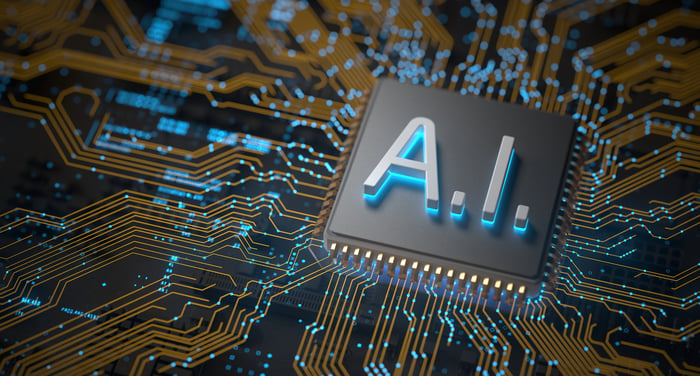It's clear that a couple of forces have been propelling the markets higher over the past year or so. Recent developments in the field of artificial intelligence (AI) helped kick-start a bull market last year, as the technology promises to unleash a tidal wave of productivity increases. Market watchers are also keen to know when the Federal Reserve might begin lowering interest rates and how quickly those rate cuts might progress.
With that as a backdrop, several AI-related stocks were sinking Tuesday. As of 1:16 p.m. ET, semiconductor specialist Advanced Micro Devices (AMD -4.76%) had slumped 3.7%, AI software maker C3.ai (AI -2.64%) was down 2.8%, chip designer Arm Holdings (ARM -3.24%) had dropped 1.8%, and chip maker Micron Technology (MU -0.07%) was also off by 1.8%
A check of all the usual suspects -- regulatory filings, financial reports, and changes to analysts' price targets -- showed nothing in the way of company-specific news to explain those falling share prices, which suggests investors are focused on broader economic developments.

Image source: Getty Images.
A rate cut in June? Not so fast
Market watchers have been eager for the Fed to begin dialing down its benchmark interest rate -- an event that will be a major indicator that U.S. inflation is finally under control. Yet Fed Chair Jerome Powell threw cold water on investors' hopes Friday, suggesting that while the central bank does still plans to cut the federal funds rate this year, it isn't in any hurry to start doing so. In a speech at the Federal Reserve Bank in San Francisco, Powell said the Fed is looking for "more good inflation readings" and doesn't want to jump the gun and change monetary policy before inflation is under control.
On Tuesday morning, the Institute for Supply Management (ISM) released its highly watched ISM manufacturing index, which rose to 50.3, up from 47.8 and higher than the level of 48.1 expected by economists. Any number over 50 is indicative of growth in the manufacturing sector, which illustrates that inflation has yet to be fully tamed and adds to the mounting pile of indicators that the Fed may not cut rates as quickly as market watchers had hoped. It also suggests that the chances of a rate cut in June may be fading.
That view was reinforced by the resilient jobs data released on Tuesday by the Bureau of Labor Statistics. Job openings were virtually unchanged at 8.8 million, while the number of hires and separations were also little changed at 5.8 million and 5.6 million, respectively.
The robust economic growth signaled by strong manufacturing and jobs data suggests that while inflation is waning, it's not yet under control.
Why it matters
So, what does this have to do with our quartet of AI stocks? In short, when borrowing money costs more, businesses are less likely to adopt game-changing -- and costly -- technologies like generative AI. When money is tight, managers are content to postpone that type of spending until borrowing costs are lower.
- AMD provides graphics processing units (GPUs) that facilitate the training and use of AI models. These systems can cost tens of thousands of dollars or more per chip, making borrowing costs a consideration for many would-be buyers of them.
- C3.ai provides ready-built software models for enterprises, which companies may be unwilling to adopt when money is tight.
- Arm Holdings creates the blueprints upon which many widely used semiconductors are based, receiving licensing fees and royalties for the use of its designs. Higher inflation and slower adoption of tech could result in lower revenue.
- Micron Technology makes flash memory and storage processors that are critical components of AI processing, so it, too, is affected by higher interest rates.
You get what you pay for
In terms of their valuations, this group of stocks is a mixed bag, though none are particularly cheap based on the most widely used metrics. Arm Holdings, AMD, C3.ai, and Micron currently trade for 27 times, 9 times, 9 times, and 4 times forward sales, respectively. However, when measured using a forward price/earnings-to-growth (PEG) ratio -- which factors in a company's current growth rate -- Arm Holdings, Micron, and AMD clock in at less than 1, the standard for an undervalued stock. C3.ai is the riskiest of the four, as the company has yet to generate a profit.
It's still early innings for AI, so there is plenty of upside ahead. That said, investing in AI-related companies isn't for the faint of heart. Those considering it should carefully weigh their risk tolerance and ability to withstand the gut-wrenching volatility that's sure to continue.





